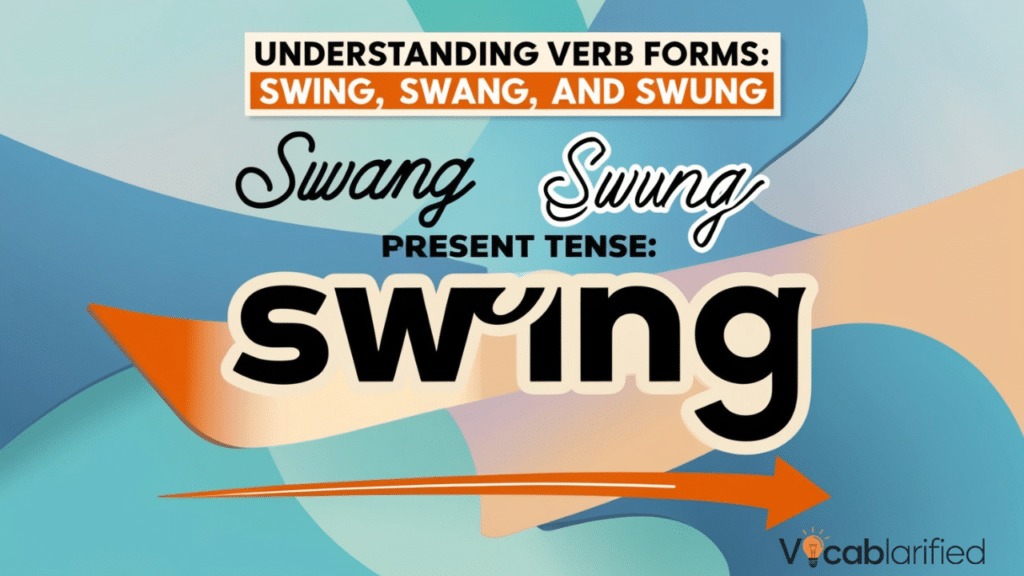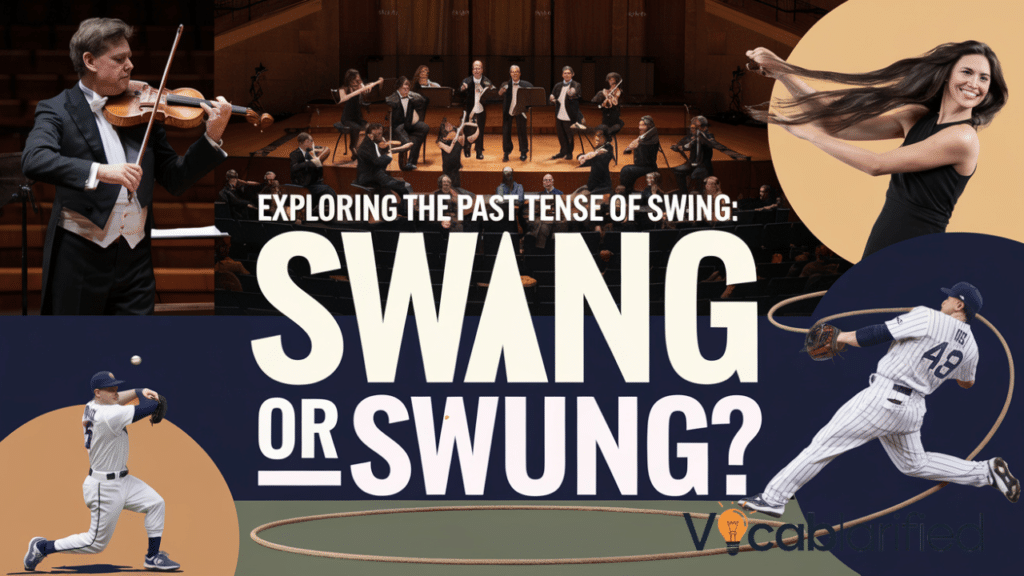The English grammar landscape is riddled with fascinating linguistic puzzles, and the verb “swing” presents one such intriguing challenge.
Many language learners and even native speakers often find themselves perplexed about the correct past tense of swing. Is it swing, swang, or swung? This comprehensive exploration will unravel the mysteries surrounding this versatile verb and provide clarity on its various forms and usage.
The Linguistic Journey of Swing
Swing represents a dynamic verb with rich language evolution that has captivated linguists and language enthusiasts for generations. Its journey through time reveals fascinating linguistic patterns that demonstrate the complexity of irregular verbs in the English language. The verb itself carries both literal meaning and figurative meaning, making it a versatile word in communication.
Verb Forms Demystified
Principal Verb Forms
Understanding the principal verb forms is crucial for mastering communication skills. The verb “swing” follows an irregular pattern that might challenge learners seeking straightforward conjugation rules.
| Verb Form | Present Tense | Past Tense | Past Participle |
|---|---|---|---|
| Swing | I swing | I swung | I have swung |
| Swing | You swing | You swung | You have swung |
| Swing | He/She/It swings | He/She/It swung | He/She/It has swung |
| Swing | We swing | We swung | We have swung |
| Swing | They swing | They swung | They have swung |
| Swing | People swing | People swung | People have swung |
| Swing | Children swing | Children swung | Children have swung |
| Swing | Athletes swing | Athletes swung | Athletes have swung |
| Swing | Musicians swing | Musicians swung | Musicians have swung |
| Swing | Dancers swing | Dancers swung | Dancers have swung |
You Might Like: Or vs Nor | What’s the Difference and When to Use Each?
The Pronunciation Puzzle
Pronunciation plays a significant role in understanding the verb’s forms. The word “swung” is pronounced with a short “u” sound, creating a melodic transition between its different tenses. Native speakers intuitively understand these nuanced language conventions without much conscious effort.
Contextual Usage Exploration
Literal Interpretations
In its most basic form, “swing” describes a movement involving back-and-forth or side-to-side motion. For instance, a child swinging on a playground represents the most straightforward application of this verb.
Email Example:
To: Emily Thompson
From: Michael Roberts
Subject: Playground Memory
Dear Emily,
I remember how you used to swing on the playground during our childhood summers. Yesterday, I swung by our old neighborhood and felt nostalgic about those carefree days.
Best regards,
MichaelFigurative Meanings
Swing extends beyond physical movement, encompassing metaphorical and situational contexts. It can describe changing opinions, political shifts, or musical styles.
| Figurative Context | Example Sentence | Tense Used |
|---|---|---|
| Musical Style | The jazz band swung with incredible energy | Past Tense |
| Political Sentiment | Public opinion swung dramatically | Past Tense |
| Decision Making | The committee’s vote swung in our favor | Past Tense |
| Emotional State | His mood swung between excitement and anxiety | Past Tense |
| Career Trajectory | Her career swung upward after the promotion | Past Tense |
| Athletic Performance | The match swung in favor of the underdogs | Past Tense |
| Economic Trend | Stock markets swung unpredictably | Past Tense |
| Creative Expression | His writing style swung between genres | Past Tense |
| Relationship Dynamic | Their relationship swung between love and conflict | Past Tense |
| Cultural Trend | Fashion trends swung wildly that decade | Past Tense |
You Might Like: What’s the Plural of Axe? Is it Axes or Axen?
Common Grammatical Challenges
Navigating Verb Forms
Many learners struggle with common mistakes related to the past tense of “swing”. The irregular nature of this verb requires careful attention to sentence structure and writing clarity.

Incorrect forms like “I swing yesterday” or “I swinged” are common errors that demonstrate the complexity of English grammar rules. Vocabulary development demands understanding these nuanced transformations.
Professional Communication Insights
Communication skills are significantly enhanced by mastering such irregular verbs. Professionals across various domains benefit from precise language usage.
Advanced Linguistic Analysis
Etymological Roots of Swing
The word swing has a fascinating historical trajectory that illuminates its language evolution. Originating from Old English “swingan,” the verb has undergone significant transformations through centuries of linguistic development. Synonyms of swing include words like oscillate, sway, and pendulate, each carrying subtle nuances in meaning and application.
Grammatical Precision in Usage
Navigating Tense Complexities
Understanding the past tense of swing requires more than memorization. It demands a deep appreciation of language conventions and contextual application. Native speakers instinctively differentiate between swang and swung based on subtle linguistic cues.
| Verb Variation | Grammatical Accuracy | Contextual Example |
|---|---|---|
| Swang | Historically Contested | Regional dialect usage |
| Swung | Standardized Form | Widely accepted |
| Swing | Present Tense | Current action |
| Swinging | Continuous Action | Ongoing movement |
| Have swung | Perfect Tense | Completed action |
| Will swing | Future Tense | Anticipated movement |
| Would swing | Conditional Mood | Hypothetical scenario |
| Should swing | Suggestive Mood | Recommended action |
| Could swing | Potential Action | Possible movement |
| Must have swung | Deductive Reasoning | Implied past action |
You Might Like: Successfully Or Succesfully: Which One Is Correct And Why?
Professional Writing Insights
Writing clarity emerges from understanding the subtle distinctions in verb usage. Professionals across various domains rely on precise grammatical constructions to communicate effectively.
Contextual Email Demonstrations
Professional Communication Example
Email Example:
To: Alexandra Rodriguez
From: David Thompson
Subject: Project Swing Analysis
Dear Alexandra,
I have carefully reviewed the project metrics. Our team's approach swung from traditional methods to innovative strategies, ultimately delivering exceptional results. We have swung into a new phase of organizational development.
Best regards,
DavidAcademic Communication Scenario
Email Example:
To: Professor Elizabeth Chen
From: Michael Rodriguez
Subject: Research Methodology
Dear Professor Chen,
During my research, I observed how scientific paradigms swung dramatically between different theoretical frameworks. The research methodology I have swung toward demonstrates more comprehensive analytical approaches.
Respectfully,
MichaelLinguistic Nuances and Pronunciation
Phonetic Exploration
Pronunciation plays a critical role in understanding verb forms. The transition from “swing” to “swung” involves a subtle phonetic transformation that challenges language learners.
| Pronunciation Aspect | Phonetic Description | Example Utterance |
|---|---|---|
| Present Tense | Short “i” sound | “I swing the bat” |
| Past Tense | Short “u” sound | “I swung the bat” |
| Continuous | Soft “ing” ending | “I am swinging” |
| Emphatic | Stressed pronunciation | “He SWUNG with force!” |
| Whispered | Soft articulation | “She swung quietly” |
| Rapid speech | Compressed sounds | “Swung it fast” |
| Formal pronunciation | Deliberate enunciation | “I have swung the object” |
| Colloquial usage | Reduced articulation | “Swung by real quick” |
| Emotional emphasis | Varied tone | “He SWUNG with passion!” |
| Academic pronunciation | Precise articulation | “The pendulum swung methodically” |
Grammatical Error Prevention
Common Misconceptions
Students and professionals often encounter common mistakes when using irregular verbs. The verb “swing” presents unique challenges in sentence structure and contextual usage.
Incorrect forms like “I swanged” or “I have swing” immediately signal grammatical inexperience. Vocabulary development requires understanding these nuanced transformations.
Cultural and Linguistic Significance
Beyond Grammatical Rules
Swing transcends mere grammatical classification. It represents a dynamic linguistic expression that captures movement, emotion, and transformation across various contexts.
Practical Application Strategies
Mastering Verb Forms
Developing communication skills involves practicing verb forms in diverse scenarios. Contextual learning proves more effective than rote memorization.
Recommended Learning Approaches
Immersive language experiences, reading diverse texts, and engaging in conversations help internalize complex verb transformations. Listening to native speakers provides invaluable insights into natural language usage.
Concluding Linguistic Reflections
The journey through the past tense of “swing” reveals the intricate beauty of English grammar. What initially appears complex becomes an opportunity for linguistic exploration and vocabulary development.
Linguistic patterns demonstrate that language is a living, breathing entity. The verb “swing” symbolizes this dynamism, continually adapting and evolving through human communication.
Mastering such irregular verbs transforms language learners from mere participants to confident communicators.

Emma Carter is an experienced blogger at Vocablarified. She enjoys helping people expand their vocabulary and improve their language skills. With a warm and approachable writing style, Emma makes learning new words fun and accessible. When she’s not writing, she loves reading books and discovering new phrases to share with her readers. Emma is passionate about making language learning an enjoyable journey for everyone.







